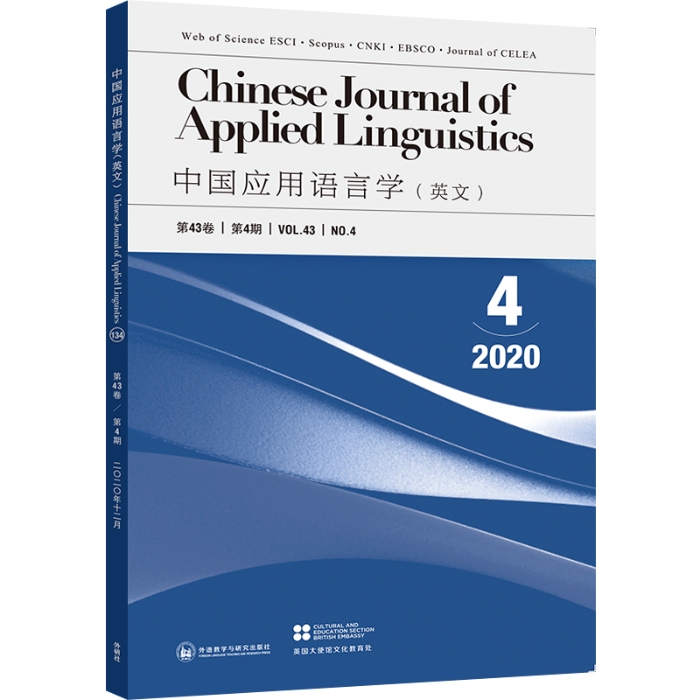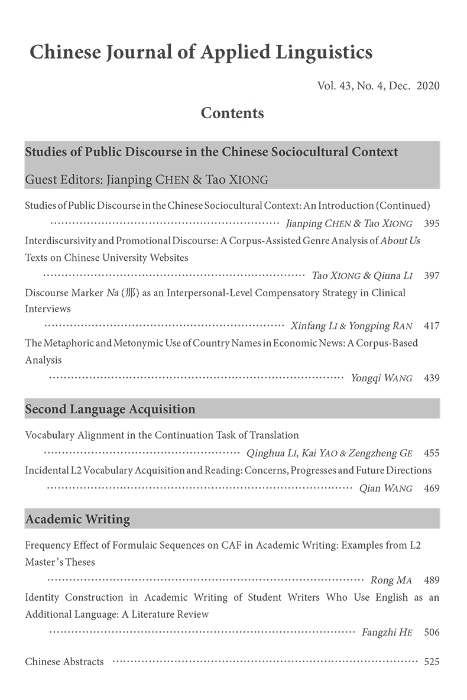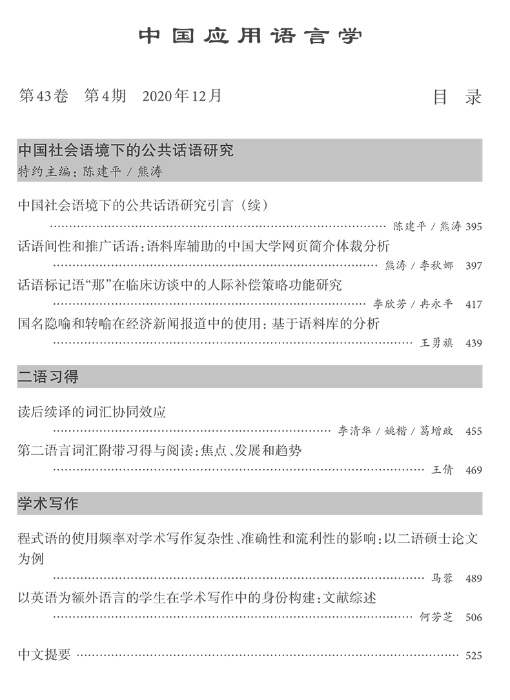《中国应用语言学(英文)》2020年第4期 目录摘要

本期目录



Interdiscursivity and Promotional Discourse: A Corpus-Assisted Genre Analysis of About Us Texts on Chinese University Websites
Tao XIONG
Center for Linguistics and Applied Linguistics,
Guangdong University of Foreign Studies
Qiuna LI
School of English Education,
Guangdong University of Foreign Studies
Abstract:
The debate on the marketization of discourse in higher education has sparked and sustained interest among researchers in discourse and education studies across a diversity of contexts. While most research in this line has focused on marketized discourses such as advertisements, little attention has been paid to promotional discourse in public institutions such as the About us texts on Chinese university websites. The goal of the present study is twofold: first, to describe the generic features of the university About us texts in China; and second, to analyze how promotional discourse is interdiscursively incorporated in the discourse by referring to the broader socio-political context. Findings have indicated five main moves: giving an overview, stressing historical status, displaying strengths, pledging political and ideological allegiance, and communicating goals and visions. Move 3, displaying strengths, has the greatest amount of information and can be further divided into six sub-moves which presents information on campus facilities, faculty team, talent cultivation, disciplinary fields construction, academic research, and international exchange. The main linguistic and rhetorical strategies used in these moves are analyzed and discussed.
Keywords:About us text, Chinese universities, genre analysis, interdiscursivity, marketization, promotional discourse

Discourse Marker Na (那) as an Interpersonal Level Compensatory Strategy in Clinical Interviews
Xinfang LI
School of English Education, Guangdong University of Foreign Studies
Yongping RAN
Center for Linguistics and Applied Linguistics, Guangdong University of Foreign Studies
Abstract:
Discourse markers (DMs) are characterized by multifunctionality in different contexts. This study addressed the use of the Chinese DM, na (那), as a solution to topical divergence, during clinical interactions with right-hemisphere-damaged (RHD) patients. Drawing on data collected from clinical interviews between psychotherapists and RHD patients, this study examined the functions of na in response to RHD topical divergence, focusing on the topic and attitudinal aspects. It was found that na was mainly employed by psychotherapists to mark a reproffer of interview topics (i.e., an attempt to return to earlier topics), and a display of disalignment and disaffiliation with RHD topical divergence. These functions of na reflect the psychotherapists’ attempts to overcome communicative problems arising from RHD topical divergence, so as to ensure the achievement of the communicative goal. Thus, na can be interpreted as a compensatory strategy for dealing with RHD topical divergence on an interpersonal level. These findings not only expand our knowledge about the function spectrum of na, but also offer insights for RHD patients’ interlocutors to enhance conversational communication with RHD patients via the compensatory strategy.
Keywords: discourse marker, clinical interview, compensatory strategy, topic reproffer, disalignment, disaffiliation

The Metaphoric and Metonymic Use of Country Names in Economic News:A Corpus-Based Analysis
Yongqi WANG
Guangdong University of Foreign Studies
Abstract:
Personification is widely acknowledged for its central role in the understanding of a nation.However, empirical evidence of its pervasiveness in authentic language data is lacking. In a self-built corpus of news report, this study coded, categorized, and analyzed the metaphoric and metonymic use of two country names: China and Australia. The distribution of the use of country names shows a continuum ranging from the literal, through metonymy, to metaphor. A clear majority of the figurative use of national names in the corpus lies in the category of metonymy, and the fuzzy area between metonymy and metaphor. In contrast, metaphors only take up a minor proportion, and most of them are based on metonymic link. By examining the mundane and seemingly literate use of country names, this study exemplifies that consistent patterns of conventional metonymy and metaphor are able to incur significant cognitive impact. Thus, this study calls for more attention on metonymy and metonymy-metaphor interaction in empirical studies on metaphor.
Keywords: country name, personification, metaphor and metonymy, cognitive linguistics

Vocabulary Alignment in the Continuation Task of Translation
Qinghua LI
School of Foreign Studies, Southern Medical University
Kai YAO
Second Clinical Medical College, Southern Medical University
Zengzheng GE
Peking Union Medical College Hospital, Chinese Academy of Medical Sciences
Abstract:
Alignment effect in language research refers to the social cognition process in which people cooperate, adjust, and adapt to each other in interaction. Through empirical study, this paper explores alignment effect in the continuation task of translation (CTOT) and its possible influence on learning of English as foreign language (EFL). The study was carried out by means of a CTOT.Participants were chosen from non-English major freshmen of similar capacity from a university in Guangzhou. They were divided into two groups, the experimental group (EG) and the control group (CG), with 13 students each. The students in EG were asked to carefully read some English-Chinese bilingual material. Then, the 26 participants were tasked with translating the paragraphs,which followed from Chinese into English. After that, they were asked to write down the words and expressions which they found difficult. Some of the participants were interviewed one month later for a deeper understanding of their memories of the vocabulary and their opinions on the CTOT.The data were analyzed by direct comparison and non-parametric test. The results showed that vocabulary alignment does occur in CTOT. The EG members tended to take advantage of words that appeared in the bilingual reading text. If multiple words from the reading appeared, with the same contextual meaning, they tended to choose the repeated words. As for influence of vocabulary alignment on EFL learning, it seemed that CTOT could not improve the quality of the translation itself, but could assist short-term vocabulary learning though no significant help to long-term vocabulary learning was revealed. The findings of this study provide support and explanation for some features and effects of CTOT, an important form of CT. However, the nature of CTOT itself, and its role in EFL learning deserve further research.
Keywords: continuation task of translation, alignment, translation teaching, EFL learners

Incidental L2 Vocabulary Acquisition and Reading: Concerns, Progresses and Future Directions
Qian WANG
Northwestern Polytechnical University
Abstract:
There has been a consensus that vocabulary knowledge has become a major contributor to L2 learners ’ efficient communication and comprehension. Incidental vocabulary acquisition relates to lexical gains as a by-product resulting from accomplishing another activity which is not aimed at learning vocabulary. This article intends to provide a digest of research on incidental vocabulary acquisition over the past few decades by primarily focusing on related theoretical frameworks,possible explanatory variables mediating incidental vocabulary learning, and tasks targeted at enhancing incidental lexical growth. In line with analyses of findings yielded from an impressive number of illuminating studies conducted, this article calls for a diversification of efforts in relation to multi-word lexical items, multi-modal e-learning technologies, and insights from neuroscience that may warrant more scholarly attention. These possible areas would further enrich the current scope of L2 incidental vocabulary acquisition research.
Keywords: second language learning, incidental vocabulary acquisition, mediating variables, development trends

Frequency Effect of Formulaic Sequences on CAF in Academic Writing: Examples from L2 Master’s Theses
Rong MA
Qufu Normal University
Abstract:
This study was conducted to explore the individual uses of formulaic sequence (FS)frequency and their effects on complexity, accuracy, and fluency(CAF)in academic writing. Data was collected from the conclusion sections of a self-compiled corpus of 30 L2 master’s theses. Statistical analysis revealed several notable conclusions. 1) Student writers tend to make repetitive use of particular FSs in single texts. 2)FS use has a significant frequency effect on fluency, and the high-frequency group slightly outperforms the low-frequency group. 3) FS use has a certain frequency effect on accuracy, and the high-frequency group demonstrates the strongest correlation between FS frequency and accuracy. 4) FS use has a significant frequency effect on lexical complexity, and the low-frequency group slightly outperforms the high-frequency group. In the low-frequency group, FS use has a significant frequency effect on syntactic complexity as well. Finally, 5) The results support Skehan’s trade-off effect, a competition between CAF, which, to a certain degree, is affected by individual uses of FS frequency. The low-frequency group displays a greater trade-off effect than the high-frequency group.
Keywords: formulaic sequence, frequency, fluency, accuracy, complexity

Identity Construction in Academic Writing of Student Writers Who Use English as an Additional Language: A Literature Review
Fangzhi HE
Zhengzhou University of Light Industry / University of Rochester (USA)
Abstract:
Academic writing is social interaction between writer and reader, during which writers can employ discursive and non-discursive features to construct their identities. However, many student writers who are users of English as an additional language(EAL)may find it challenging to construct their identities in academic writing. Properly constructed identity in academic writing can help EAL student writers develop a stronger sense of self, exercise their agency, and negotiate the academic discourse. Therefore, this paper reviews empirical studies on EAL student writers’ identity construction when they write in English to investigate the features of identities that EAL student writers construct in texts and the factors that influence their identity construction. The findings show that, compared with expert writers and native-English-speaking (NES)counterparts, EAL student writers tend to present a weak authorial identity. Furthermore, EAL student writers tend to be more engaged with texts than with readers and lack commitment to their claims. The identities that EAL student writers construct in academic writing are also interwoven with EAL students’English proficiency levels, educational experience, disciplinary conventions, genre affordances, and audience awareness. The findings of this literature review can help teachers and educators raise EAL students’ identity awareness and facilitate students in strategically constructing writer identities in academic writing.
Keywords: academic writing, English as an additional language (EAL) students, identity construction







